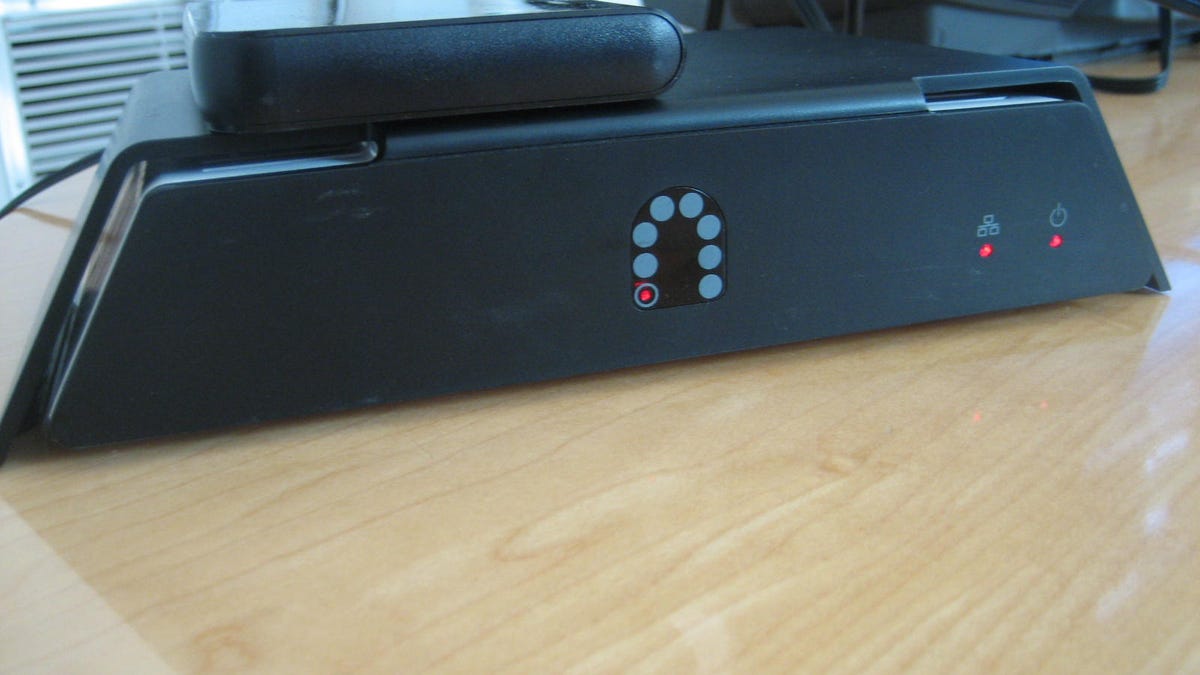First impressions: Sling Media SlingCatcher
CNET offers a hands-on impression of Sling Media's long-delayed digital media receiver.

Last week, the folks from Sling Media stopped by to give us a hands-on look at the SlingCatcher. Originally due in 2007, the long-delayed product looks to be finally ready to ship this fall. (The video below is Molly Wood's preview of the SlingCatcher when it was reintroduced in January 2008.)
As the name suggests, the SlingCatcher is a hardware version of the SlingPlayer software that's available for various devices. Connect the SlingCatcher to your bedroom TV, for instance, and you can access the live TV and recorded programs from your living room DVR (which, in turn, is connected to a Slingbox).
So, instead of being limited to the small-ish screens of a laptop (or even a mobile phone), you're back to watching TV on...a TV.
The SlingCatcher can access any Slingbox that you've added to your Sling.com account, but the same caveats apply to it as with the software SlingPlayers. Most notably, only one client can access a given Slingbox at a time.
Bandwidth constraints apply (streaming within a home network generally looks great, but remote Slingbox resolution will be limited by upstream bandwidth at the source location). And the Slingbox monopolizes the AV source to which its connected (if you log in to your DVR and start playing Desperate Housewives while somebody's in the living room watching football, they'll suddenly see Eva Longoria instead of Eli Manning.
During Sling's demo, we accessed both a SlingPlayer Pro-HD setup on our internal network, as well as a live satellite box feed from across the country. The HD source (a football game playing back on a TiVo HD) looked stunning, since it was able to use the full bandwidth of a wired network connection without traveling over the outside Internet. The remote feed, a daytime talk show, was traveling thousands of miles and compressed almost 10 times as much. As a result, it exhibited considerably more jaggies and looked like a YouTube video maximized to full screen--but it was certainly watchable. The included SlingCatcher remote was mapped to the source box, so we could change channels, access the DVR listing, play/pause and rewind--albeit all with a delay, as the signals were transmitted across the long distance.
The SlingCatcher's ability to be a Sling viewer is certainly cool, but that's a niche feature, to be sure. Thankfully, the box offers two other features: playback of all sorts of digital media (via the USB input) and the ability to mirror anything on a PC screen. On the media playback front, the box offers compatibility with a laundry list of non-DRM'd codecs and file formats--WMV, MPEG-2, MPEG-4, H.264, Xvid, MP2, MP3, WMA, AAC, AC3, avi, .vob, .ifo, .ps, .ts, .mpg, .wmv, .asf, .mov, .mp4,.m4v, .mp3, .wma, .mp4a, .m4a, and .wav. Drag and drop your files onto a USB storage device (hard drive, flash drive, what have you), plug it in to the Catcher, and you can use the remote to navigate to whatever file name you'd like and play it at the click of a button. (Files can also be automatically synced across the network to the attached storage device, using a method called SlingSync.)
What about those DRM files or Flash videos available on Web sites like Hulu, ABC.com, and YouTube? That's where the SlingProjector software comes in. Run the SlingProjector software (currently Windows only), and your PC screen--or whatever portion of the screen you specify--is immediately mirrored on your TV through the SlingCatcher. On the surface, it's a somewhat kludgy solution--you'll pretty much need to keep a laptop on the coffee table for quick and easy access--but in practice, it worked surprisingly well.
We noted a lip-sync issue with a Hulu video, but this was, after all, a beta version of the software. On the bright side, it's very straightforward: if you can see it on your screen, you can Sling it to your TV. That includes video from any source (including iTunes, Netflix, or anything else), photos, PowerPoint presentations--the works.
All in all, the SlingCatcher was looking smoother and more polished than the early build we'd seen at CES in January. The "compass" interface was gone, but the new menu system was straightforward and easy to navigate. It looks to be most useful for in-house access to other SlingPlayers, and as a makeshift universal media player. It may still be a bit too niche-y for mass market appeal, but--after spending less than an hour with it--we'd much rather be watching Hulu on a $300 SlingCatcher than, say, a $500
We'll have a full review (with additional photos and video) later this fall, once we get a production version of the SlingCatcher. In the meantime: do you have any interest in the SlingCatcher? If not, is there a missing "killer app" that you'd like to see added? Share your thoughts below.
Editors' note: Sling Media and CBS (the parent company of CNET) are working together on Sling's Clip-n-Sling project and CBS' Interactive Audience Network.

